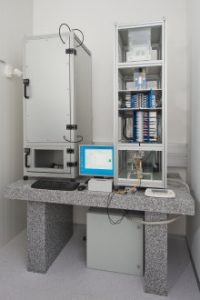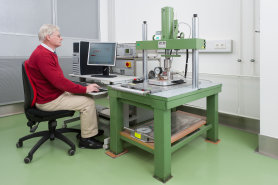Force

Force is a vector quantity, whose derived SI unit is the Newton (N).
One Newton is the force needed to accelerate a mass of one kg by 1 m/s2.
BEV uses force standard machines with different working areas to realise and generate static forces (tension or compression) from 0.5 kN to 5 MN. These machines work according to the principles of direct mass load or hydraulic amplification. Forces up to 20 kN can be generated with deadweight-loads in the gravitational field.
A lever arm coupled to the stacks of masses helps to generate forces up to 200 kN at a ratio of 1:10.
Higher forces of 200 kN to 1MN and of 1 MN to 5 MN are generated hydraulically at a ratio of 1:50 or 1:250.These force standard measurement devices are computer-controlled. BEV’s force standard measurement devices are calibrated periodically by the Physikalisch-Technische Bundesanstalt (PTB), Germany.
Advancing material complexity calls for exact analysis of material properties to determine possible fields of application in research, industry and commerce.
For product and quality assurance, the maximum force that a material can withstand under a static load until it breaks is determined with profound material tests.
To determine this force precisely the force measuring instruments must be regularly inspected.
The calibration of these measuring instruments with the standard force measuring devices of BEV ensures their traceability to the SI.

Verification of axle weighing systems
Axle weighing systems are subject to mandatory verification in Austria. Only instruments approved by BEV are accepted for verification. Besides the national type approval there exists the possibility of an type approval under the European Economic Area Agreement (EEA Agreement) referred to as EEC Type Approval. Axle weighing systems are verified by the verification authority. They have to be reverified every two years.